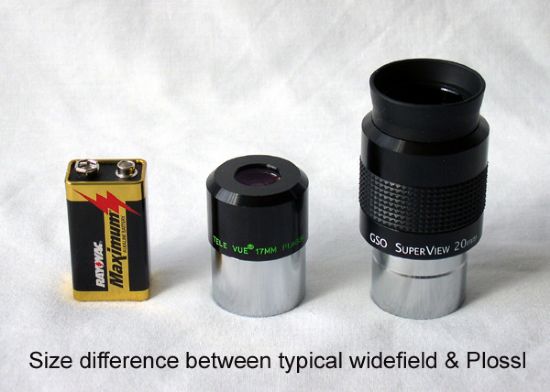Buying Eyepieces
Part 3 of an article about eyepieces by Antony McEwan
Is it Worth it?
Now although I own four very expensive Pentax eyepieces, that does not mean I paid top price for them. Three of them were bought second hand via Astronomy classified ads over the Internet, and, all told, they probably cost me about the same as a single brand new Nagler! I have also bought a large number of excellent Televue plossls second hand over the last couple of years, paying as little as £18 for one, and an average price of just £50 each. Special mention should be made of Televue plossls as they have performed brilliantly in every single telescope I’ve tried them in, delivering very high contrast images and being very lightweight and just plain reliable. Perfect plossls!
The second hand market can be a very good way to try new eyepieces out without committing too much money, but of course 'buyer beware'! Some interesting schools of thought exist when discussing buying expensive eyepieces. One suggests that it’s better to think of the price of an ‘expensive’ eyepiece as a ‘rental fee’ rather than a purchase, because expensive eyepieces tend to hold their value very well, and should you decide to sell it on or try something else you should be able to get most of your money back. Another view (and one I have most sympathy with) is argued very enthusiastically in a thread I read recently on the Cloudynights forum, posted by Amalia. In it she writes, “Go for the absolute best eyepiece you can afford! Don‘t buy compromise eyepieces. Find new financial solutions: To get my Pentax orthos (very highly rated - Antony) I did not pay my rent and my taxes. So what? I will pay this later. But later the Pentax orthos would have been sold to somebody else. I will have saved money because I am very sure I found ‘the eyepieces of my life’. No need to try many others and lose money every time I sell them to buy something better.”
Now that’s an eyepiece buyer’s attitude! Also consider that good quality eyepieces can be kept and used in your next telescope, and on and on indefinitely, no matter how many times you replace your telescope.

Having owned several telescopes of different prices and levels of quality, I would say that good quality eyepieces (and diagonals for refractors) are the best way of improving the views you get, provided your telescope is collimated and in good optical shape. The improvement I saw when moving up from cheap generic eyepieces to the Televue plossls was remarkable. Even in my selection of various small cheap fast refractors, the extra contrast thrown up was immediately noticeable and enabled me to see such things as the nebulosity in the Pleiades, and the Triangulum Galaxy in an f5 80mm refractor. Likewise the step up from the Televue plossls to Pentax XLs with their wider sharp fields was very rewarding. I have never regretted buying an ‘expensive’ eyepiece but I have sometimes regretted buying cheaper ones. When considering what type to buy though, you should think about what type of objects you will be looking at. If wide-fields are not important and you watch the planets most of the time, buy good quality orthos and plossls. If you want to see the Andromeda Galaxy, Double Cluster and Pleiades in all their glory, then you’ll need at least one good wide-field type. If you have an alt-azimuth mounted telescope such as a Dobsonian, wide-field eyepieces will be very useful for you, as you will have to nudge the telescope along to follow the target much less often than with an eyepiece with a narrower field. If you have to wear glasses while observing, you’d better check that the eye relief will be adequate for you.
Once you’ve got the selection narrowed down, make sure to search for reviews on the Internet or from people you know who own them. There are many sites with countless user reviews of different eyepieces, including Cloudy Nights Reviews and Excelsis. Also check out the great Telescope Calculator on our very own website and let it do the sums for you. Even better, attend local observing nights! A star party can be a great opportunity to try out other telescopes and eyepieces, and you can find out in advance if that eyepiece you’re considering shelling out £25 or £300 for is really going to work well in your telescope. Be assured that good eyepieces really can make all the difference to your telescopic views, but also be warned: trying new eyepieces is Addictive !
I’ve got to go now- a new eyepiece has just arrived and I need to check it out….
Click here to go to part 1, Eyepiece Basics